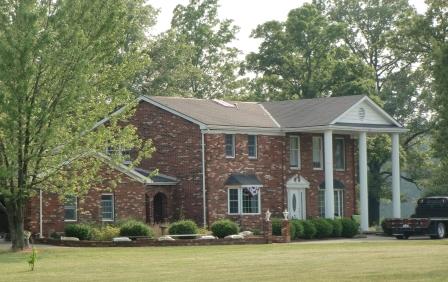Big Porch Columns That Add Nothing to Your House
#1 of 10 Home Design Mistakes
Porch column envy was problem back in the ‘60s and ‘70s. Fashion has swung against these monstrosities.
Regular readers of this site will recognize that I like the classical look, and this often includes columns. It is not the columns themselves that offend. It is that they are often used where they should not be, are sized inappropriately, or used as an ostentatious display.
Andrea Palladio got the ball rolling back in the 16th century, designing houses that looked like temples from antiquity. There are some who still take offense to this innovation, but at least he understood the classical proportions and respected them. The classical revival that followed spawned houses that looked nothing like houses of antiquity, but owed a deep debt to the public buildings of that era.
The problem with columns is primarily a problem of the modern era. It isn’t a problem with the modernists. They hate columns, at least anything that presents itself as being something more than a post for supporting a part of the house.
The problem comes with the Colonial and Classical Revival houses that were so common in the twentieth century. Some of these did a great job with columns. Unfortunately throwing up a few columns became a shortcut for some builders. Rather than make a serious attempt at reviving a classical look, they just threw up a few columns in front of an ordinary house.

A typical problem is the use of columns that are too thin. If it is going to support a classical roof it should bear a classical look. Classical proportions weren’t entirely consistent, but many houses bear columns that are so outside the classical limits that even the untrained eye will recognize that they look odd.

Classical columns also became slightly narrower at the top. Modern columns sometimes ignore this. Straight columns are easier to make, but they don’t look right if they are trying to mimic a classic look. The technical term for the diminution of the columns is “Entasis”. Even architects who have not been classically trained probably understand the concept, but it is obvious that somebody doesn’t care because straight columns keep appearing in classical settings.
The spacing and number of columns is another mistake often made. It is not uncommon to see a Greek roof extending out over a porch being supported by only two columns. Or a much wider roof might have more columns, but still considerable fewer than would be found on a classical building. I am not really concerned whether someone is following some rules set out by a long dead architect, the problem is that those rules where there for a reason, and the houses that ignore them often look ridiculous.
All of these problems can cause me to wince when I see them, but the biggest concern is the tacking on of columns where their use doesn’t blend with the rest of the house. It is as if they hired an architect to design a house, hired another architect to design a porch and then slapped the two together.





Home Design Mistakes - Start of Series
To Top Ten
Please!
 Next
Next




New! Comments
Have your say about what you just read! Leave me a comment in the box below.